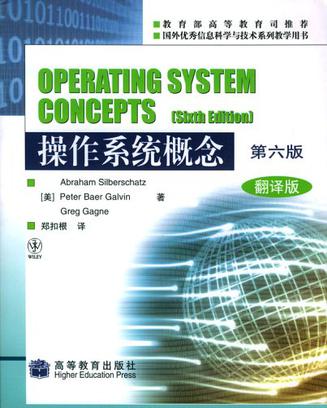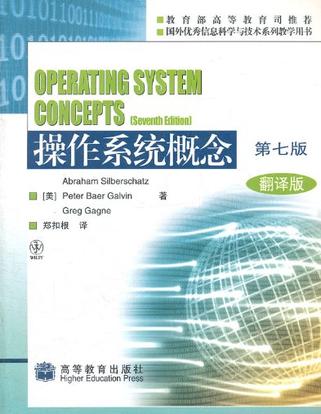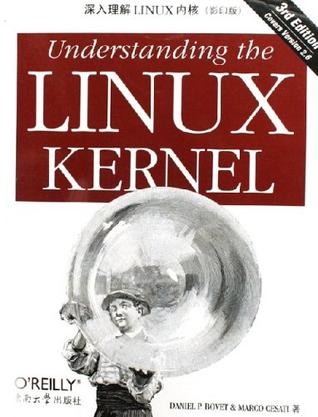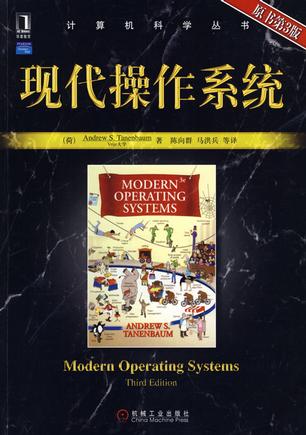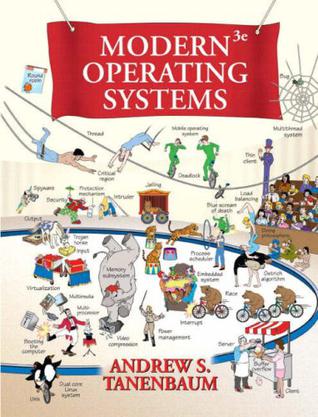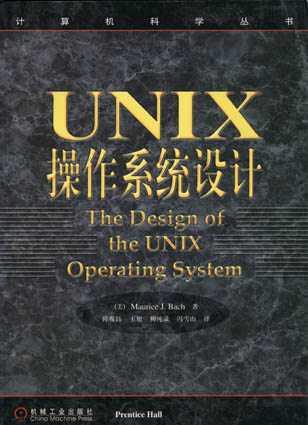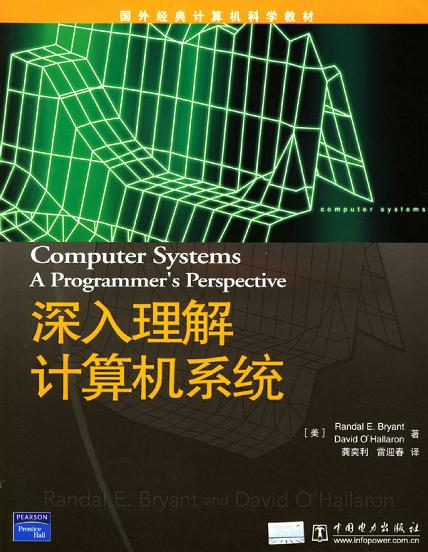欢迎来到相识电子书!
标签:OS
-
操作系统概念
《操作系统概念》(第6版翻译版)是讨论了操作系统中的基本概念和算法,并对大量实例(如Linux系统)进行了研究。全书内容共分七部分。第一部分概要解释了操作系统是什么、做什么、是怎样设计与构造的,也解释了操作系统概念是如何发展起来的,操作系统的公共特性是什么。第二部分进程管理描述了作为现代操作系统核心的进程以及并发的概念。第三部分存储管理描述了存储管理的经典结构与算法以及不同的存储管理方案。第四部分I/O系统对I/O进行了深入的讨论,包括I/O系统设计、接口、内部结构与功能等。第五部分分布式系统介绍了分布式系统的一般结构以及连接它们的网络,讨论了分布存取策略、分布式文件系统及分布式系统中同步、通信等机制。第六部分保护与安全介绍了操作系统中对文件、内存、CPU及其他资源进行操作的安全与保护机制。第七部分案例研究,分析与讨论了Linux系统、Windows 2000、WindowsXP、FreeBSD、Mach及Nachos等实例。 -
现代操作系统
《现代操作系统(英文版)(第2版)》内容包括:INTRODUCTION、PROCESSES AND THREADS、DEADLOCKS、MEMORY MANAGEMENT、INPUTIOUTPUT、FILE SYSTEMS、MULTIMEDIA OPERATING SYSTEMS、MULTIPLE PROCESSOR SYSTEMS、SECURITY、CASE STUDY 1: UNIX AND LINUX等。 -
Operating System Concepts, Seventh Edition
Keep pace with the fast-developing world of operating systems Open-source operating systems, virtual machines, and clustered computing are among the leading fields of operating systems and networking that are rapidly changing. With substantial revisions and organizational changes, Silberschatz, Galvin, and Gagne’s Operating System Concepts, Eighth Edition remains as current and relevant as ever, helping you master the fundamental concepts of operating systems while preparing yourself for today’s emerging developments. As in the past, the text brings you up to speed on core knowledge and skills, including: What operating systems are, what they do, and how they are designed and constructed Process, memory, and storage management Protection and security Distributed systems Special-purpose systems Beyond the basics, the Eight Edition sports substantive revisions and organizational changes that clue you in to such cutting-edge developments as open-source operating systems, multi-core processors, clustered computers, virtual machines, transactional memory, NUMA, Solaris 10 memory management, Sun’s ZFS file system, and more. New to this edition is the use of a simulator to dynamically demonstrate several operating system topics. Best of all, a greatly enhanced WileyPlus, a multitude of new problems and programming exercises, and other enhancements to this edition all work together to prepare you enter the world of operating systems with confidence. -
操作系统概念
操作系统概念(第7版 影印版),ISBN:9787040209280,作者:(美)西尔伯查茨 高尔文 加根 -
操作系统概念(第六版 影印版)
本书是计算机类专业操作系统课程的一本经典教材,自第一版问世以来,经历了近20年的锤炼,被认为是该课程教材的一本圣经。它对操作系统的概念和基本原理给出了清晰的阐述。本书所涉及的基本概念和算法均基于当前商用操作系统,并在非特定操作系统的通用环境中展开讲解。书中介绍了大量与流行操作系统相关的实现技术,包括Solaris 2、Linux、Windows NT、Windows 2000、OS/2和Apple Macintosh操作系统。此版包括了线程、Windows 2000的新章节,并新增了客户/服务器模型和网络文件系统、嵌入式操作系统、实时操作系统、分布式操作系统等。 作者Abraham Silerschatz是贝尔实验室信息科学研究中心的副主任, Greg Gagne是威斯敏斯特学院计算机学系主任,Peter Baer Galvin曾在布朗大学计算机科学系执教,现为Corporate Technologies公司的首席技术专家。 -
操作系统概念(第七版)
《操作系统概念(第7版)(翻译版)》内容简介:非常小型的操作系统,如篇首的小恐龙所使用的驱动手持设备的操作系统,是Silberschatz、Galvin和Gagne第七版《操作系统概念》中的一种前沿应用。通过保留最新的,保持有意义的,并改编为课程最需要的内容,这本引导市场潮流的教材继续指导着操作系统课程。第七版不仅提供最新且最有意义的系统,同时还从更深层次揭示了那些在当今操作系统发展过程中仍保持不变的基本概念。通过拥有这种坚实的概念基础,学生们能更容易理解与特定系统相关的细节问题。 -
深入理解LINUX内核
为了彻底理解是什么使得Linux能正常运行以及其为何能在各种不同的系统中运行良好,你需要深入研究内核最本质的部分。内核处理CPU与外界间的所有交互,并且决定哪些程序将以什么顺序共享处理器时间。它如此有效地管理有限的内存,以至成百上千的进程能高效地共享系统。它熟练地统筹数据传输,这样CPU不用为等待速度相对较慢的硬盘而消耗比正常耗时更长的时间。 《深入理解Linux内核,第三版》指导你对内核中使用的最重要的数据结构、算法和程序设计诀窍进行一次遍历。通过对表面特性的探究,作者给那些想知道自己机器工作原理的人提供了颇有价值的见解。书中讨论了Intel特有的重要性质。相关的代码片段被逐行剖析。然而,本书涵盖的不仅仅是代码的功能,它解释了Linux以自己的方式工作的理论基础。 本书将使你了解Linux的所有内部工作,它不仅仅是一个理论上的练习。你将学习到哪些情况下Linux性能最佳,并且你将看到,在大量的不同环境里进行进程调度、文件存取和内存管理时,它如何满足提供良好的系统响应的需要。这本书将帮助你充分利用Linux系统。 -
现代操作系统(第3版)
本书是操作系统领域的经典之作,与第2版相比,增加了关于Linux、Windows Vista和Symbian操作系统的详细介绍。书中集中讨论了操作系统的基本原理,包括进程、线程、存储管理、文件系统、输入/输出、死锁等,同时还包含了有关计算机安全、多媒体操作系统、掌上计算机操作系统、微内核、多核处理机上的虚拟机以及操作系统设计等方面的内容。此外,还在第2版的基础上对部分习题进行了增删,更有助于读者学习和对知识的理解及掌握。 本书适合作为高等院校计算机专业操作系统课程教材,也是设计、开发操作系统的重要参考书。 Tanenbaum教授作为三个操作系统的设计师或联合设计师,具有长期设计开发操作系统的经验,从而把其对理论的深入理解和具体实践融入书中,使本书成为操作系统领域的经典之作。 在本书第3版中,作者深入讨论了许多主题,包括:进程、线程、存储管理、文件系统、I/O、死锁、接口设计、多媒体、性能权衡,以及有关操作系统设计的最新趋势。书中不仅涵盖了现代操作系统的原理和实践,而且特别关注了Linux操作系统、Windows Vista操作系统、嵌入式操作系统、实时操作系统以及多媒体操作系统。 本书特色: ● 涉及Windows Vista以及最新的Linux/UNIX操作系统。 ● 用一整章(第12章)的篇幅对用于移动设备的Symbian操作系统进行分析。 ● 涵盖更多、更新的安全方面的内容。 ● 重新组织内容,尽早论述关键抽象概念。 ● 给出与未来操作系统发展有关的新研究成果。 ● 更新和增加了编程练习。 ● 在线操作系统练习(http://www.prenhall.com/tanenbaum/details.html)采用主流Windows操作系统以及开源工具。 ● 包括操作系统模拟练习。 -
Modern Operating Systems
For software development professionals and computer science students, Modern Operating Systems gives a solid conceptual overview of operating system design, including detailed case studies of Unix/Linux and Windows 2000. What makes an operating system modern? According to author Andrew Tanenbaum, it is the awareness of high-demand computer applications--primarily in the areas of multimedia, parallel and distributed computing, and security. The development of faster and more advanced hardware has driven progress in software, including enhancements to the operating system. It is one thing to run an old operating system on current hardware, and another to effectively leverage current hardware to best serve modern software applications. If you don't believe it, install Windows 3.0 on a modern PC and try surfing the Internet or burning a CD. Readers familiar with Tanenbaum's previous text, Operating Systems, know the author is a great proponent of simple design and hands-on experimentation. His earlier book came bundled with the source code for an operating system called Minux, a simple variant of Unix and the platform used by Linus Torvalds to develop Linux. Although this book does not come with any source code, he illustrates many of his points with code fragments (C, usually with Unix system calls). The first half of Modern Operating Systems focuses on traditional operating systems concepts: processes, deadlocks, memory management, I/O, and file systems. There is nothing groundbreaking in these early chapters, but all topics are well covered, each including sections on current research and a set of student problems. It is enlightening to read Tanenbaum's explanations of the design decisions made by past operating systems gurus, including his view that additional research on the problem of deadlocks is impractical except for "keeping otherwise unemployed graph theorists off the streets." It is the second half of the book that differentiates itself from older operating systems texts. Here, each chapter describes an element of what constitutes a modern operating system--awareness of multimedia applications, multiple processors, computer networks, and a high level of security. The chapter on multimedia functionality focuses on such features as handling massive files and providing video-on-demand. Included in the discussion on multiprocessor platforms are clustered computers and distributed computing. Finally, the importance of security is discussed--a lively enumeration of the scores of ways operating systems can be vulnerable to attack, from password security to computer viruses and Internet worms. Included at the end of the book are case studies of two popular operating systems: Unix/Linux and Windows 2000. There is a bias toward the Unix/Linux approach, not surprising given the author's experience and academic bent, but this bias does not detract from Tanenbaum's analysis. Both operating systems are dissected, describing how each implements processes, file systems, memory management, and other operating system fundamentals. Tanenbaum's mantra is simple, accessible operating system design. Given that modern operating systems have extensive features, he is forced to reconcile physical size with simplicity. Toward this end, he makes frequent references to the Frederick Brooks classic The Mythical Man-Month for wisdom on managing large, complex software development projects. He finds both Windows 2000 and Unix/Linux guilty of being too complicated--with a particular skewering of Windows 2000 and its "mammoth Win32 API." A primary culprit is the attempt to make operating systems more "user-friendly," which Tanenbaum views as an excuse for bloated code. The solution is to have smart people, the smallest possible team, and well-defined interactions between various operating systems components. Future operating system design will benefit if the advice in this book is taken to heart. --Pete Ostenson --This text refers to the Hardcover edition. Product Description The widely anticipated revision of this worldwide best-seller incorporates the latest developments in operating systems technologies. The Third Edition includes up-to-date materials on relevant operating systems such as Linux, Windows, and embedded real-time and multimedia systems. Includes new and updated coverage of multimedia operating systems, multiprocessors, virtual machines, and antivirus software. Covers internal workings of Windows Vista (Ch. 11); unique even for current publications. Provides information on current research based Tanenbaum’s experiences as an operating systems researcher. A useful reference for programmers. -
UNIX操作系统设计
本书内容包括 UNIX内核体系结构 磁盘高速缓冲机制 文件系统内部数据结构与算法 控制进程上下文的系统调用与进程调度 存储管理,包括对换和请求调页系统 通用驱动程序接口,包括磁盘驱动程序和终端驱动程序 进程间通信与网络,包括系统V消息、共享存储和信号量 紧密耦合的多处理机UNIX系统和松散耦合的分布式UNIX系统 本书可作为大学计算机科学系高年级学生和研究生的教材或参考书,也为从事UNIX系统研究与实用程序开发人员提供了一本极有价值的参考资料。 -
深入理解计算机系统
从程序员的视角,看计算机系统! 本书适用于那些想要写出更快、更可靠程序的程序员。通过掌握程序是如何映射到系统上,以及程序是如何执行的,读者能够更好的理解程序的行为为什么是这样的,以及效率低下是如何造成的。粗略来看,计算机系统包括处理器和存储器硬件、编译器、操作系统和网络互连环境。而通过程序员的视角,读者可以清晰地明白学习计算机系统的内部工作原理会对他们今后作为计算机科学研究者和工程师的工作有进一步的帮助。它还有助于为进一步学习计算机体系结构、操作系统、编译器和网络互连做好准备。 本书的主要论题包括:数据表示、C程序的机器级表示、处理器结构,程序优化、存储器层次结构、链接、异常控制流、虚拟存储器和存储器管理、系统级I/O、网络编程和并发编程。书中所覆盖的内容主要是这些方面是如何影响应用和系统程序员的。例如,在讲述数据表示时,本书说明了用来表示数字的表示方法是有限的,它能够近似地表示整数和实数,但是这种表示方法是有限制的,程序员必须了解。在讲述高速缓存时,本书讨论了矩阵代码中的循环变量的顺序是如何影响程序的性能的。在讨论网络互连时,本书描述了并发服务器如何能有效地处理来自多个客户端的请求。 本书基于Intel兼容(IA32)机器,在Unix或者相关的操作系统(例如,Linux)上执行C程序。虽然书中包括了一些帮助读者将Java转化成C的提示,但是还是要求读者对C或者C++有一定的了解。 您可以通过本书的Web网站www.csapp.cs.cmu.edu获得完整的资料,包括实验和作业,授课笔记和代码示例。 本书英文版久负盛名,被众多专业人士称为“最伟大的计算机教材”之一,著名的美国卡内基梅隆大学计算机科学系一直将本书作为教材使用,程序员眼中的透彻讲述计算机系统的扛鼎之作。作者Randal E. Bryant是卡耐基梅隆大学的计算机科学系主任,ACM和IEEE双院士(Fellow),其研究成果多次获得ACM和IEEE颁发的大奖。 本书共分十三章,分别介绍了信息的表示和处理、程序的机器级表示、处理器体系结构、存储器层次结构、静态和动态链接、虚拟存储器、系统级I/O、网络编程和并发编程等精彩内容。其目的是解释计算机系统的所有本质概念,并向读者展示这些概念是如何实际地影响应用程序的正确性、性能和实用性。与其他主要针对系统构造人员的系统类书籍不同,这本书是写给程序员的,是从程序员的角度来描述的。本书为软件和硬件之间搭起了一个桥梁,它给出了一种帮助读者分别从硬件和软件的角度去理解一个程序及其行为的途径,这也填补了国内计算机系统教学中的一个空白。本书的最大优点是帮助读者理解概念,让读者很清楚地在脑海中构造一个层次型的计算机系统,从最低层数据在内存中的表示(如我们一直陌生的浮点数表示),到流水线指令的构成,到虚拟存储器,到编译系统,到动态加载库,到最后的用户应用。 本书提供了大量的例子和练习及部分答案。尤其值得一提的是,对于每一个基本概念都有相应的笔头或程序试验,加深读者的理解。
热门标签
下载排行榜
- 1 梦的解析:最佳译本
- 2 李鸿章全传
- 3 淡定的智慧
- 4 心理操控术
- 5 哈佛口才课
- 6 俗世奇人
- 7 日瓦戈医生
- 8 笑死你的逻辑学
- 9 历史老师没教过的历史
- 10 1分钟和陌生人成为朋友

